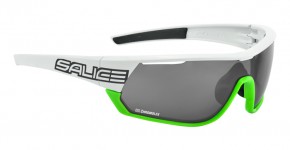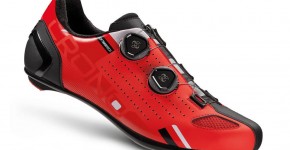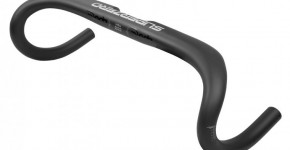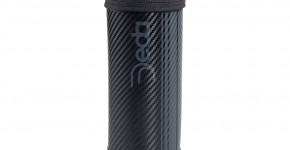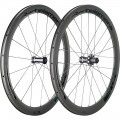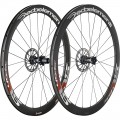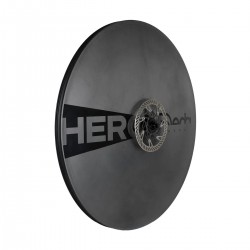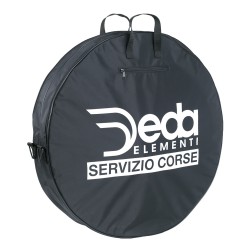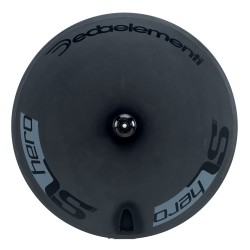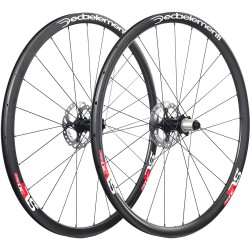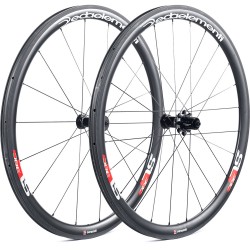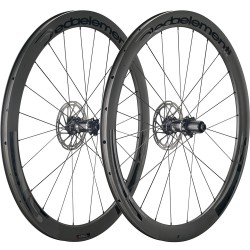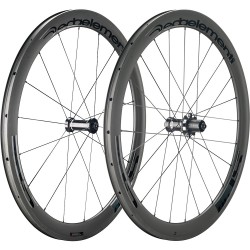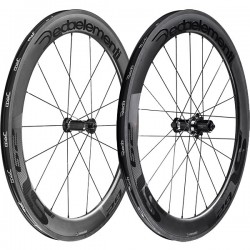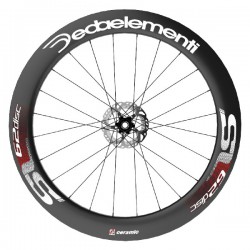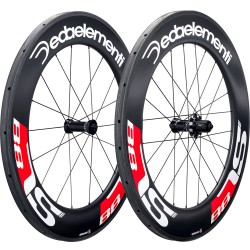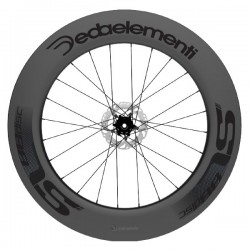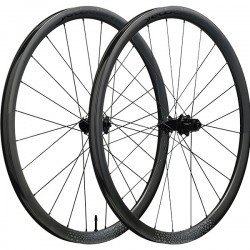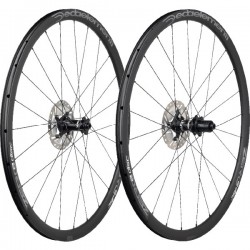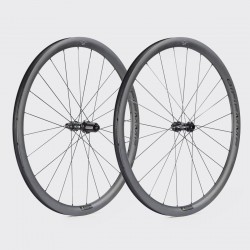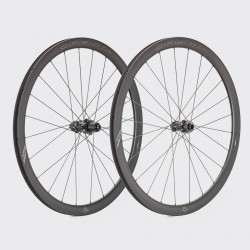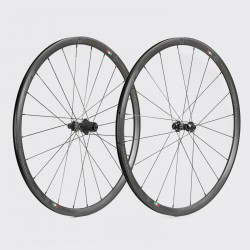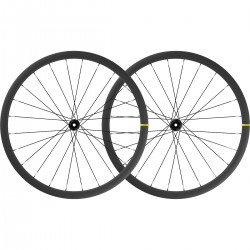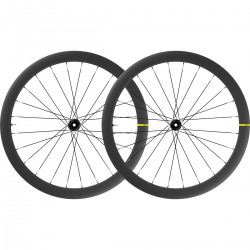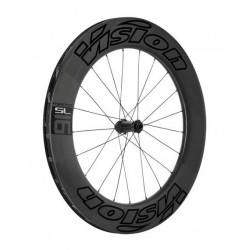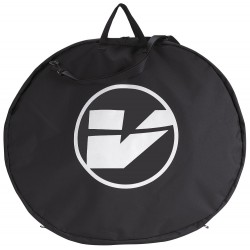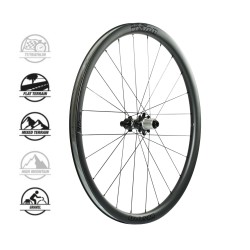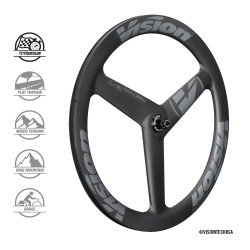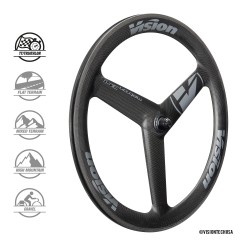Országúti kerékpár kerékszettek

A kerékszett cseréje, jobbra váltása talán az egyik legnépszerűbb "upgrade" a kerékpársok közt. Nem véletlenü, hiszen egy jól kiválasztott kerék rengeteget változtathat a kerékpár viselkedésén, az úthibák elnyelésével kényelmesebbé teheti, oldalirányú merevség növelésévelhatékonyabbá teheti a tekerést. A kerekek szó szerint mozgásban tartanak, az első alkatrésze a kerékpárnak ami találkozik az aszfalttal és átviszi az energiádat a talajra, csökkenti az útvibrációt, a felületi tökéletlenségeket és a terepváltozásokat. A bringa sokak szerint legfontosabb alkatrésze, fontos hogy a stílusodnak, felkészültségednek, megfelelő kereket válaszd!
Mielőtt csak a külső megjelenés és a súly adatok alapján választanál, érdemes elolvasni az alábbiakat, talán segít kicsit tisztábban látni!
A kerék felépítése
A kerékpár keréknek négy fő alkatrésze van, amelyek mindegyike befolyásolja a súlyt, a teljesítményt és a tartósságot. Ezeknek az alkatrészeknek a minősége befolyásolhatja a menetkényemet, a hatékonyságot, a fékteljesítményt, gördülési ellenállást - ezért érdemes tudni mindegyikről egy kicsit, hogyan befolyásolják a kerék minőségét.
- felni: A kerék felnije a kerék külső oldalán helyezkedik el, és két fő funkciója van; a gumiabroncs megtartása és fékezőfelület biztosítása (felnifékes kerekeknél, a tárcsafékesnél nem). A felni szélessége befolyásolja a használható gumiabroncs szélességét, ami jelentős hatással lehet a vezető kényelmére, a fékfelület anyaga pedig befolyásolja a fékteljesítményt.
- kerékagy vagy csak agy: az agy a kerék közepén helyezkedik el, és biztosítja a forgást a bele szerelt tengellyel és csapágyakkal - mind az első mind pedig a hátsó kerék esetében. A tengely rögzíti, kapcsolja a kereket a kerékpárhoz. A hátsó kerékagyban (agyon) található a rotor (szabadonfutó) amire kerül a sor (vagy kazetta a lánckerekekkel) ez biztosítja a kerékpáros hajtásakor ez erő átvitelét a hajtásról a kerékre, illetve ha a kerékpáros nem teker, akkor a szabadonfutó biztosítja a kerék független forgását az álló hajtástól. A kerékpár lánca a kazetta lánckerekei köré fonódik, és a hajtókarral és a váltókkal együtt alkotja a kerékpár hajtásláncát, amely az erőátvitelt és az előre haladást biztosítja.
- Küllők: az alkatrész, amely összeköti az agyat és a felnit. A küllők száma az első és a hátsó kerekek között eltérő lehet, a hátsót gyakran több küllővel látják el az erő és a merevség javítása érdekében. A több küllő általában erősebb kereket jelent, de ez nyilván többlet súllyal is jár. A küllők különböző anyagokból készülnek (acél, alu, karbon), és különböző formájúak lehetnek (kör keresztmetszetű vagy aerodinamikus lapított kivitelű). A küllők leggyakrabban acélhuzalból készülnek, de alakjuk és átmérőjük nagyon eltérő lehet.
- Küllőanyák (nippli): A küllők egy speciális anyával, úgynevezett „nipplivel” csatlakoznak a kerékhez, felnihez. A kerékanyák fontosak a küllők feszességének beállításához, ezzel "centirozza" a kereket, és egyenessé teszi annak futását, amikor forog.
Milyen egy jó kerék?
A jó kerék kiválasztása nagymértékben függ a felhasználástól. Átalánosságban elmondható, hogy egy jó kerékkészlet tartós, megbízható (szerelhető, tartalék alkarészek cseréjével javítható) agyakkal rendelkezik, megfelelő fékezést, fékhatást biztosít, merev az ezzel hozzájárul a hatásos erőátvitelhez, ugyanakkor - nem utolsó sorban - könnyű is.
Itt már érezhetjük, hogy az egyes szempontok egymásnak ellentmondhanak, ezért lesz ez igazán jó és könnyű kerék, nagyon drága!
A könnyű kerekek csökkentik a forgó súlyt az alacsony felniprofilnak és kevés küllőszámnak köszönhetően. Az össztömeg csökkentése mellett ennek az előnye a kényelem, mivel a függőleges irányban ébredő erőkkel (útról érkező rezgések, ütések) szemben némi csillapítást biztosíthat. A magasabb profilú felnikkel szerelt kerekek gyorsak - igazából könnyebb velük tartani a sebességet - de a menetminőséget gyakran „durvábbnak” érezni. A minőségi, könnyű kerékszettek általában 1400 gramm alattiak, az igazán "top kategória", rendkívül könnyű példányok akár az 1000 gramm-ot is megközelítik!
Az aerodinamikus kerekek célja, hogy a légellenállás csökkentésével a lehető leggyorsabbak legyenek. Az aerodinamikus kerekek általában 40 mm-nél magasabb profilúak, és manapság egyre szélesebbek is. Ennek azonban megvannak a hátrányai is, mivel a sokkal érzékenyebbek az oldalszélre, ami megnehezítheti a kezelésüket, az extra anyag pedig növeli a súlyt.
A nem annyira teljesítményre koncentráló kerékpárok általában olyan tulajdonságokkal rendelkeznek, amelyek alkalmasabbá teszik őket mindennapi használatra vagy általános edzésre . A fékfelület alumíniumból készült, amely minden időjárási körülmény között jobb teljesítményt nyújt a karbonhoz képest (bár az újabb kompozit fékbetétek már meglepően jó fékhatást biztosítanak a karbon felnikkel is), nagyobb küllőszámot használnak a szilárdság és tartósság növelésére, és a felni szélesebb, hogy szélesebb gumiabroncsokat is tudjon használni. Ennek megfelelően tömegük is növekszik, általában 1500 és 1800 gramm közt található.
A csomagos túrákra vagy a nagyobb súlyú bringásokhoz (120 kg feletti) készült kerkek, nagyobb küllőszámmal, 32 vagy akár 36 küllővel szereltek. Az extra merevség és tartósság miatt a kerekek tömege ebben a formában általában meghaladja az 1900 grammot.
Felni anyaga
A alsó szintű kerekek többsége különböző minőségű alumínium felnikkel érkezik, míg a komolyabb - akár versenyzésre is szánt - kerekek jellemzően karbon (szénszálas) felnikkel rendelkeznek, ami csökkenti a tömeget, egyben növeli a merevséget.
Az alumínium, mint felni anyag jobb fékteljesítményt biztosít, mint a karbon, amely általában gyengén teljesít nedves úton és hosszú lejtőzések során, mivel fékezés közben felmelegszik. Ezekél nagyon fontos a felnihez ajánlott megfelelő (általában a gyári) fékbetét használtata.
Egyes gyátók kínálatában vannak karbon felnis de alumínium fékfelülettel szerelt modellek is, bár ezek manapság eltűnőben vannak mert sokszor elveszik a karbon felnik kínálta könnyebb súly. Érdemes azonban megjegyezni, hogy ezek a kialakítások akár nehezebbek is lehetnek, mint az egyanyagú felni.
Felni- vagy tárcsafék
Talán az egyik legaktuálisabb kérdés manapság, bár az igazságot megvallva a kérdés talán már el is dőlt - természetesen a tárcsafék javára - ha azt nézzük, hogy a legtöbb gyártó kezdi elhagyni (talán csak a "low end" kategóriában marad) a felni féket. Persze, mindig lesznek akik vallásos megszállottsággal érvelnek a felnifék mellett..
A tárcsafékre való átállás jó ideje elkezdődött, és mára sztenderdé vált az országúti kerékpárokon. A felnifék és a hagyományos féknyeregtől elhagyása új lehetőségeket nyitott a gyártóknak mind a váz, mind a kerék kialakítása, szélesebb gumik használata, valamint a megnövekedett fékerő nyilvánvaló előnyei terén.
A tárcsaféket használó kerékpárok módosított felniprofillal készülhetnek ez még aerodinamikusabb és a gyorsabb kerekek megvalósítását teszik lehetővé. Hátránya, hogy a tárcsás kerékpárok vázának erősebbnek kell lenniük ahhoz, hogy megbirkózzanak a nagyobb fékerővel, továbbá több küllőre és speciális agyakra van szükség, ami potenciálisan enagyobb súlyt eredményez.
A tárcsafékes rendszer előnye leginkább a karbon kerekeknél jön ki, mivel ott a karbon felni fékhatása a felnifékes rendszernél jóval kisebb (nedves időjárási körülmények közt sokszor kifejezetten gyenge) volt. Továbbá, mivel nem a fék kopik a drága tárcsafékes karbon kerekek élettartama is sokkal hosszabb, használatuk biztonságát a kopás előre haladása nem befolyásolja, mivel nem a felni hanem a féktácsák használódnak el.
A tárcsafékekkel való használatra tervezett kerekeket nem szabad összetéveszteni az aerodinamikus „tárcsa” kerekekkel, amelyek egyetlen darabot alkotnak a kerékagytól a peremig annak érdekében, hogy csökkentsék a szélturbulenciát az időfutam versenyeken.
Felni szélesség és profil magasság
A kerék felnijének szélessége és magassága nagymértékben meghatározza, hogyan halad és viselkedik a kerékpár.
A mai trend az, hogy a modern felnik egyre szélesebbek, ami jobb aerodinamikát és jobb kényelmet eredményez a szélesebb és balonosabb gumiabroncsok nagyobb rugózást adó levegőmennyisége révén. A közemúltban több gyártó és független kutató és tesztcsoport is mérésekkel vizsgálta és igazolva látta, hogy a szélesebb gumiabroncsok alkalmazása (a sebesség függvényében) állítólag javítja (alacsonyabb) a gördülési ellenállást és a kényelmet, és akár alacsonyabb nyomáson is futhatnak.
A felni szélessége mérhető belülről vagy kívülről, ami zavaró számokat eredményezhet ha össze szeretnénk hasonlítani kerekeket vagy próbálunk eligazodni, hogy egy felivel milyen szélességű gumit fogunk tudni használni. Általában, ha egy márka egy számra hivatkozik, amelyet „C” követ, ez egy belső méretet jelent. A jelenlegi szabványok szerint a keskeny felni belső méréssel 15 mm alatti, míg a széles felni belső méréssel 17 mm-nél szélesebb. Külső mérést véve a 19 mm alatti számít keskenynek, míg a 22 mm-nél nagyobb szélesnek tekinthető.
Bár szorosan összefügg egymással, a külső felniszélesség leginkább a kerekek aerodinamikáját, míg a belső felniszélesség a kényelmet, a gördülési hatékonyságot vagy a gumiabroncs formáját befolyásolja.
A felni profilmagassága befolyásolja a kerék aerodinamikáját és a kerékpár kezelhetőségét. Általában minél magasabb a felni, annál aerodinamikusabb, de annál nehezebben kezelhető, mivel az oldalszél jobban "belekap", mint egy alacsony peremesbe. A anyagtöbblet nagyobb súlyt eredményez - ezért elmondható, hogy nehezebben gyorsítható, viszont könnyebben tartható vele a sebesség. Érdemes megjegyezni, hogy nem minden mély felni készül egyformán, és a pontos profil márkánként nagyon eltérő. A gyártók folyamatos szálcsatornás tesztelésekkel próbálják elérni a tökéletes felni formát, ami oldalszélben is jól viselkedik és persze megfelelően gyors is. Sokszor a márkák ajánlással adnak, hogy a kerék melyik gumitípussal hozza a legjobb eredményt a méréseik szerint.
Maga profilúnak mondjuk általában a 40 mm-t meghaladó magasságú a felniket, némelyikük pedig 80 mm-nél is nagyobb, de van 105mm is.
A küllők
A kerék küllőinek teljes száma, alakja és anyaga változhat. A magas küllőszám növeli a robusztusságot és a tartósságot, de súlytöbblettel jár. A küllők többféle anyagból készülhetnek, beleértve acélt, alumíniumot, szénszálat és titánt. Az acél küllők messze a leggyakoribbak.
Az első és a hátsó kerekek küllőszáma változó, a hátsó kerekek küllőinek száma általában több, mivel nagyobb erőhatásnak vannak kitéve (hajtóerő és többletsúly). A könnyű első kerék jellemzően 18-24 küllős, míg a hátsó kerék 20-28 küllős. Ez éles ellentétben áll a kerékgyártás korai napjaival, amikor az első kerekek több mint 30 küllővel rendelkeztek, a hátsó kerekek pedig több mint 40-el. Az anyagok és a gyártási folyamatok javulásával a küllők száma csökkent, csökkentve a tömeget azonos teljesítmány mellett.
A lapos küllő - amelyet gyakran „kardküllőnek” neveznek - aerodinamikai előnyöket biztosít a lekerekített küllőkhöz képest. Bár drágábbak, merevek és könnyűek.
A normál küllők vagy „egyenes húzásúak” vagy „J-hajlításúak”. Az „egyenes húzású” küllők fejénél nincs hajlítás, és speciális agyakat igényelnek, a „J-hajlítású” küllők a hagyományosabb megoldás, 90 fokos hajlítással az agy végén, amely „J” betűnek tűnik.
Az egyenes küllők előnyei: pontosabb beállítás, merevebb, jobban reagáló kerék és súlycsökkenés. Az egyenes húzó küllők hátránya, hogy sok cég saját fejlesztésű küllőket és kerékagyakat gyárt, ami azt jelenti, hogy a csereküllő beszerzése időigényes és költséges lehet. A J-bend küllők gyakran könnyebben cserélhetők, és minőségük és szilárdságuk szempontjából az egyenes húzó küllőkhöz közeli teljesítményt nyújtanak.
A küllő lehet "húzott", azaz a teljes hossza mentén változó átmérőjű, a súlycsökkentés elérése végett.
Szabadonfutó és/vagy rotor
A hátsó kerék agyának része a rotor és a szabadonfutó mechanika, ez biztosítja, hogy amikor tekerünk akkor az erő átadódik a keréknek, ha abbahagyjuk a pedpálozást akkor pedig a hátsó kerék szabadon fut (pont mint az első).
A különböző váltási rendszerekhez különböző rendszerű fogaskerék sorok és ahhoz illesztett rotorra van szükség - ezek kompatibilitásának ellenőrzése a kerék vásárlásakor elengedhetetlen! Jellemzően ezek a gyártók szerint Shimano, SRAM - ezek 9 10 11 sebességes rendszereknél általában kompatibilisek, 12 sebességnél már nem. Míg a harmadik - egyben mára legkisebb - Campagnolo olasz gyártó fogaskerék sorai ezektől eltérő rendszerűek, nem kompatibilis a másik kettővel (a rotorra való felszerelés tekintetében).
Csapágyak
Minél drágább egy kerékpár, a felhasznált alkatrészek minősége is úgy emelkedik. Az kerékagyon belüli csapágyak esetében ez jellemzően azt eredményezi, hogy az általánosan használt acél csapágyakat a komolyabb felső kategóriás kerekekben már kerámia csapágy váltja. A jó kerámia csapágy, felületei simábbak, anyaga keményebb és tartósabb, így simább és hosszabb élettartamú futást biztosít mint egy ezzel egyenértékű acélcsapágy. Kisebb súrlódás, jobb hatékonyság és teljesítmény! Azonban vannak csúcsminőségű acél csapágyak amik minőségben még ezeket is felülmúlják - általában kevésbé tartósak.
A csapágyak anyaga mellett a megfelelő kenés is befolyásolja a gördülést és a keletkező súrlódás mértékét. A csapágyak súrlódása csökkenti a teljesítményt és lelassítja a kerekeket. Túlzott súrlódás lép fel, ha a csapágyak nincsenek megfelelően kenve, ha por, szennyeződés vagy más anyag kerül a csapágyakba, vagy ha a csapágyakból nagynyomású mosással kiöblítik a kenőanyagot. Itt a jobb minőségű kerékagyak jobb tömítést biztosítanak a külső behatásoktól, így azok hosszabb ideig simábban gördülnek.
Minél alacsonyabb a kenőanyag viszkozitása, annál kisebb a súrlódás, de ennek következtében a tartósság sérülhet.
A csapágyak zárt ipari csapágyak vagy golyó-kónuszos felépítésűek. Sok gyártó a csúcs kerekeinél a mai napig nem alkalmazza az ipari csapágyakat hanem megmaradt a klasszikus bontható golyó-kónuszos megoldásnál (szerintük ezek adják a legfinomabb gördülést), ilyenek például a Campagnolo, Fulcrum de a Shimano komolyabb kerekei is!
Az ipari (zárt) csapágy egy külső és egy belső gyűrű golyópálya közt elhelyezett golyókból áll, ez préselik komplett egységként az agyhüvelybe. A tömített csapágy egyetlen egység, ha elhasználódik, akkor a teljes csapágy cseréje válik szükségessé, de ez meglehetősen olcsó.
Gumiabroncs típusok
Érdemes ismerni a három különböző típusú gumiabroncsot, amit országúti kerékszetteknél alkaznak. Mivel mindegyikhez a megfelelő speciális felnire van szükség, a kerék vásárlása előtt el kell dötenénk, hogy milyen gumit szeretnénk majd használni! Manapság a "szingós" (belső nélküli) gumik már háttérbe szorulnak, eltöbb kerékpáron úgynevezett peremes felnit és ehhez illesztett gumibelsővel szerelt gumit használnak. Egyre népszerűbb a jó defektállósága miatt a mountain bike ágazat felől érkező "tubeless" (belső nélküli - de nem azonos a korábbi "szingós" megoldással) rendszer is.
A jelenleg országúti kerékpárokon használt gumiabroncsok leggyakoribb formája a peremes gumi és belsővel szerelt megoldás. Hacsak nincs feltüntetve, feltételezhető, hogy egy újonnan vásárolt kerékpár "clincher" azaz peremes abroncsokkal rendelkezik. Ezeken a gumiarbroncsokon egy perem fut végig, ami a felnin található hornyos "árokba" illeszkedve a nyomás hatására megfeszülve marad a felnin. A nyomás megtartásáról pedig a külsőben elhelyezett belső gumi és szelep gondoskodik.
A "szingós" gumiabroncsokban is van belső, de egészen más módon. A cső alakú gumiabroncs belsőjét közvetlenül az abroncsba varrják, majd közvetlenül a felnire ragasztják fel a gumiabroncsot. A professzionális versenyzők napjainkig szinte kizárólag "szingós" gumiabroncsokat használtak, köszönhetően azok csökkentett tömegének, jó tapadásnak és irányíthatóságnak. Defekt esetén is még valamennyi ideig lehet vele haladni, illetve kicsi az esélye, hogy a gumi lefordul a felniről, ami csökkenti a balesetveszélyt.
Hátránya, hogy drága, nehézkes a cseréje, defekt javítása. Verseny körülmények közt a kereket kompletten cserélik, nem javítják a defektet.
A "tubeless" tömlő nélküli abroncsokat régóta használják a mountain bike-oknál, és manapság megérkeztek és el is terjedtek az országúti kerékpárok világában is. A Trek 2015 óta „tubeless ready” kerekeket szerel fel országúti kerékpárjainak többségére, a Giant pedig 2017-től kizárólag tömlő nélküli gumiabroncsokat kínál csúcskategóriás modelljeihez.
Ahogy a neve is sugallja, a tubeless / tömlő nélküli abroncsok nem igényelnek belsőt, hanem egy speciális felni-kialakításhoz kapcsolódnak, amely légmentes tömítést hoz létre. Ez egy nagyon hasonló technológia a modern autókban és motorokban találhatóhoz.
A tömlő nélküli abroncsok jobbnak tekinthetők, mint a clincher abroncsok, mivel kisebb súrlódást eredményeznek, ami javítja a gördülési ellenállást, alacsonyabb nyomáson is használhatók, javítva a kényelmet, és jobb defektvédelmet nyújtanak. A defektek megelőzése érdekében a tömlő nélküli gumiabroncsok folyékony tömítőanyaggal használhatók, amelyet a gumiabroncsba helyezve azonnal elzárja a kisebb defekteket.

